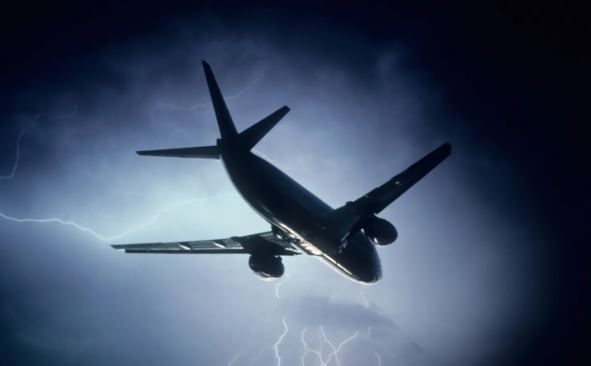This alarming scenario might sound like a rare disaster waiting to happen. Still, lightning strikes on aeroplanes are more common than one might think, occurring approximately once per aircraft annually.
While the idea of electricity meeting an airborne vessel can be unnerving, modern aviation technology ensures that these high-voltage encounters are safe for everyone on board.
In this article, we look at the fascinating science behind lightning, how aircraft are engineered to withstand such strikes and the robust safety measures that keep passengers safe.
Whether you’re an aviation enthusiast or a curious traveller, understanding the interplay between lightning and aeroplanes will demystify one of nature’s most dramatic phenomena and explain why it’s a critical topic for everyone in the skies.
Science of Lightning
Lightning is a powerful electrical discharge caused by imbalances between storm clouds and the Earth or within the clouds themselves.
This spectacular natural phenomenon occurs when the negative charges (electrons) in the bottom of the cloud are attracted to the positive charges (protons) in the ground, another cloud, or within the same cloud.
When these opposite charges build up enough tension, the insulating capacity of the air breaks down, and a rapid flow of electricity—lightning—zaps through to equalise these charges.
When lightning finds its target, the interaction is both swift and fiery. Upon striking an object, the lightning’s immense electrical current flows through it, seeking the path of least resistance to the ground.
This current can heat the air around it to an astonishing 30,000 degrees Celsius, which is about five times hotter than the surface of the sun, leading to the explosive expansion of air that creates the thunder we hear following a flash.
For objects struck, this can mean sudden and extreme temperature increases, potential burning, and electrical damage, depending on their conductive properties and the strike’s intensity.
Aircraft are designed to fly through storms, but pilots are trained to avoid them to minimize risk to aircraft and passengers.
Flight routes are planned in advance to avoid problem areas based on predicted weather movements.
Aeroplanes are marvels of engineering and have the ability to safely endure lightning strikes with minimal to no damage.
This capability is embedded in the very design and materials used to construct modern aircraft.
The primary material used in aeroplane construction is aluminium, which, aside from being lightweight and strong, is also an excellent conductor of electricity.
This conductivity is crucial because it allows the electrical charge from a lightning strike to spread quickly across the aircraft’s exterior, reducing the chance of concentrated heating and damage in any single spot.
In addition to using conductive materials, aircraft are equipped with specific design features that enhance their lightning resilience.
One such feature is the inclusion of static wicks—small, conductive extensions located at the trailing edges of the wings and tail.
These wicks are designed to dissipate the electrical charge accumulated from flying through highly charged regions in the atmosphere, thereby reducing the likelihood of a lightning strike.
Furthermore, critical systems and components, such as fuel tanks and electronic navigation instruments, are specially shielded against electromagnetic interference caused by lightning.
This shielding ensures that even if an aeroplane is struck, the vital systems remain operational, maintaining the aircraft’s functionality and safety.
The engineering standards governing these designs are rigorous, ensuring every aircraft meets stringent safety criteria before it takes to the skies.
This comprehensive approach to design not only protects the plane but also ensures the safety of all passengers and crew onboard.
Steps of what happens when lighting strikes a plane
- Initial Contact: Typically, the lightning strike initiates when the airplane flies through a highly charged area in the atmosphere. The plane itself can act as a trigger for the discharge, with the strike often attaching to a sharp extremity of the plane such as the nose or the wingtips where the electrical charge concentrates.
- Channelling the Current: Upon making contact, the lightning’s electrical current enters the aircraft at the initial strike point. Due to the aeroplane’s conductive aluminium skin, this high-voltage current rapidly spreads across the exterior of the fuselage.
- Travelling Path: The electricity moves along the path of least resistance. Aircraft designers strategically utilize the conductive framework of the plane to guide the lightning’s flow towards the extremities—such as the tips of the wings and the tail. This careful routing is crucial for controlling the energy and minimising potential damage.
- Exiting the Aircraft: After traversing the length of the aeroplane, the lightning exits, usually from another sharp point such as a static wick or the tail. These points facilitate the safe expulsion of the electrical charge back into the atmosphere.
- Dissipation: Once the lightning has exited, its residual charge dissipates into the air, and the aeroplane’s systems check for functionality. The robust shielding around critical systems ensures that the aircraft’s operational capabilities remain unaffected, allowing it to continue its flight safely.
Lightning strikes on planes are surprisingly frequent yet remarkably safe due to advanced aeronautical engineering.
On average, each aircraft is estimated to be struck by lightning once or twice per year.
Despite this frequency, the last known commercial plane crash attributed directly to lightning occurred over 50 years ago, in 1967.
Since then, improvements in aircraft design and maintenance have significantly mitigated risks, making lightning strikes a manageable aspect of flight safety.
Statistically, lightning poses minimal risk to the integrity of modern aircraft or the safety of its passengers.
The aviation industry’s rigorous standards for lightning protection ensure that the millions of commercial flights that take off each year experience lightning strikes without incident, maintaining an exemplary safety record.
Conclusion
Lightning strikes might seem like a formidable threat to aircraft, but as we’ve explored, modern aviation technology has turned this natural phenomenon into a manageable occurrence.
Aircraft are ingeniously designed with conductive materials and specialized features such as static wicks that safely channel and expel electrical charges.
These design principles ensure that when a plane is struck by lightning, the electrical current is efficiently distributed and dissipated without harming the aircraft’s structure or critical systems.
The statistical rarity of lightning-related incidents in aviation over the past several decades underscores the effectiveness of these protective measures.
Passengers can take comfort in knowing that today’s aircraft are built not just to withstand the common lightning strike, but to do so with such reliability that it barely registers as a risk in the realm of air travel.





